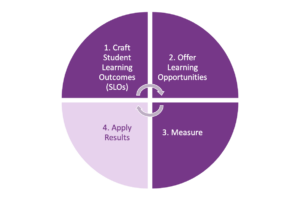The learning assessment cycle, as shown in the figure below, creates the closing-the-loop’s visual loop metaphor. Closing the loop completes the circle: we close the loop when we analyze and make meaning from learning evidence, identify potential interventions to improve learning, and implement those interventions. Double-loop analysis reminds educators to measure the closing-the-loop interventions and ascertain if they work as improvements. Together closing the loop and double-loop analysis cultivate continuous improvement.
For detailed instructions and examples see A Guide to Curriculum Mapping: Creating a Collaborative, Transformative, and Learner-Centered Curriculum (Harrison & Williams 2024), or request a consultation or workshop.
Closing the Loop & Double-Loop Analysis
Applying Results
After you have collected your direct measure data, consider the following steps:
- Reflect, Connect, Synthesize: What do the data tell you?
- Discuss, Compare, Focus: What’s working? What’s not? What areas of learning need attention first?
- Apply: Identify intervention(s) and take action at the course, program, and institutional levels.
- Double-Loop Analysis: Measure intervention results-claim successful interventions as “improvements.”
Applying and Closing the Loop
Could adjustments improve student learning? If so, consider an intervention at the appropriate level. Can you address this at the course level or do students across your program or across UMBC need help with this?
- At the course level, you can implement formative and summative interventions. If students struggle with an outcome, consider the formative question “What else can I do to help students master this SLO?” and the summative question “How can I improve learning in this SLO next time?”
- At the program level, you can share your results and collaborate to find common ground, that is, areas where you and your colleagues have successfully helped students to learn and areas that need our collective attention. Consider what your program can do collectively to improve learning.
- If you discover a learning challenge that crosses the curriculum (and gather evidence to document it), you can make a good case for an institutional-level intervention.
When faculty see solutions that result from learning assessment, the checklist mentality diminishes. For example, when UMBC leaders discovered that transfer students struggling to adapt to their new learning environment, UAA developed Transfer Seminars, designed to improve the transition for transfer students.
FDC Learning Assessment Resources | Student Learning Outcomes | Curriculum Mapping | Direct Measures: Rubrics & Tests | Selected Learning Assessment References
Text and graphics created by Jennifer M. Harrison, Ph.D.
